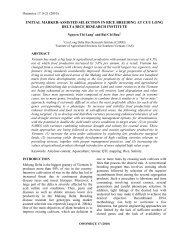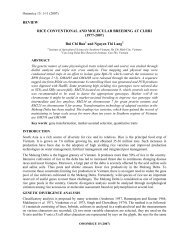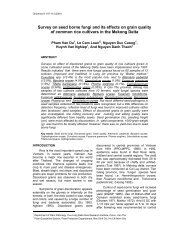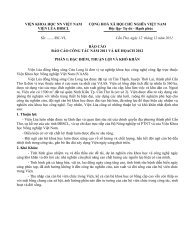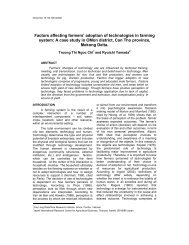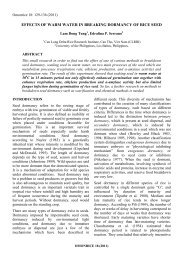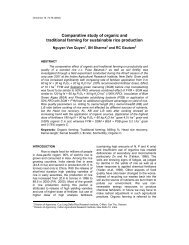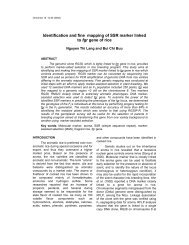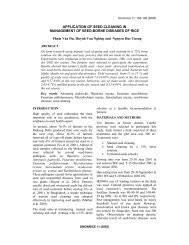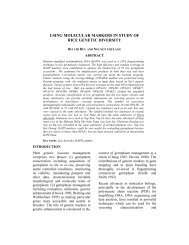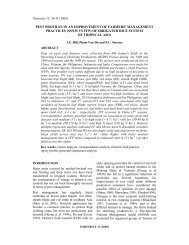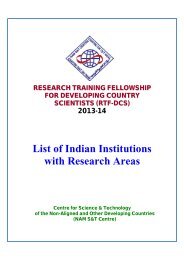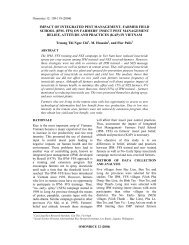BIOCONVERSION OF PADDY STRAW AND BIOFERTILIZER FOR ...
BIOCONVERSION OF PADDY STRAW AND BIOFERTILIZER FOR ...
BIOCONVERSION OF PADDY STRAW AND BIOFERTILIZER FOR ...
You also want an ePaper? Increase the reach of your titles
YUMPU automatically turns print PDFs into web optimized ePapers that Google loves.
58<br />
certain others would generally accumulate in<br />
excess resulting in nutrient imbalance, which<br />
affects soil productivity and environmental<br />
pollution.<br />
Among the means available to achieve<br />
sustainability in agricultural production, suitable<br />
cropping systems, organic manure and biofertilizer<br />
play an important and key role because<br />
they possesses many desirable soil properties and<br />
exerts beneficial effect on the soil physical,<br />
chemical and biological characteristics of the soil.<br />
The result of trials on rice crop studied by CLRRI<br />
indicated that rice straw treated by Trichoderma<br />
fungi inoculant then application of composted rice<br />
straw at 6 tons/ha or in combination with different<br />
farmer’s doses of chemical fertilizer at 40, 60,<br />
80% NPK improved significantly soil<br />
microorganisms, electron transport system<br />
activities and total protein (Luu Hong Man et. al.,<br />
2003). The role of biological nitrogen fixation<br />
(BNF) in supplying plants with needed N, which<br />
can make agriculture more productive and<br />
sustainable without harming the environment, has<br />
to be efficiently harnessed. Plant growth is directly<br />
influenced by the available of reduced N, leading<br />
to the long accepted practice of manuring,<br />
fertilizer application, or rotational crop practices<br />
(Dang Kim Son, 1986; Gresshoff and Rao, 1987).<br />
Nitrogenous chemicals account for as much as<br />
30% of the total fertilizer needed for agricultural<br />
crops, with the increasing cost of chemical<br />
fertilizers and concern about environmental<br />
pollution. Studies indicate that rhizosphere, roots,<br />
stems and leaves of even healthy plants harbour<br />
diverse microbial communities that include N 2<br />
fixing bacteria as rhizobia and free living bacteria<br />
(Azotobater, Azospirillum, Herbaspirillum…) or<br />
Gluconacetobacter diazotrophicus, a promising<br />
diazotrophic endophyte (Muthukumarasamy et al.<br />
2002). The long-term field experiment on soybean<br />
conducted at Can tho showed that the quality<br />
nutrient contents and uptake of soybean with<br />
reference to N, P and K and soil available P and K<br />
were significantly improved by application of<br />
composted paddy straw and inoculants viz.<br />
Rhizobium fredii and Bradyrhizobium sp (Tran Thi<br />
Ngoc Son et al., 2003). After N, phosphorus (P) is<br />
the major plant growth-limiting nutrients despite<br />
being abundant in soils in both inorganic and<br />
Tran Thi Ngoc Son et al.<br />
organic forms. However, many soils throughout<br />
the world are P-deficient because the free<br />
phosphorus concentration (the form available to<br />
plants) even in fertile soil is not higher than 10 µM<br />
even at pH 6.5 where it is most soluble<br />
(Gyneshwar et al., 2002). To circumvent the<br />
problem of P deficiency, chemical fertilizers are<br />
added to the soils but cost of chemical phosphatic<br />
fertilizers is high (Goldstein et al., 1993) and low<br />
efficiency (



